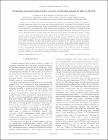| dc.contributor.author | SHVETS, IGOR | en |
| dc.contributor.author | MARIOTTO, GUIDO | en |
| dc.contributor.author | MURPHY, SHANE | en |
| dc.date.accessioned | 2010-07-15T10:14:32Z | |
| dc.date.available | 2010-07-15T10:14:32Z | |
| dc.date.issued | 2002 | en |
| dc.date.submitted | 2002 | en |
| dc.identifier.citation | Murphy, S.; Mac Mathúna, D. M.; Mariotto, G.; Shvets, I. V., Morphology and strain-induced defect structure of ultrathin epitaxial Fe films on Mo(110), Physical Review B (Condensed Matter and Materials Physics), 66, 19, 2002, 195417 | en |
| dc.identifier.other | Y | en |
| dc.identifier.uri | http://hdl.handle.net/2262/40366 | |
| dc.description | PUBLISHED | en |
| dc.description.abstract | Fe films in a coverage range of 0.4<~?<~4.7ML were deposited on a Mo(110) substrate in the 300<~T<~700K temperature range. It is found that growth around 300 K is mediated by the step-flow growth mechanism, in contrast with previous studies of the Fe/Mo(110) and Fe/W(110) systems, where growth at 300 K was mediated by two-dimensional island nucleation and coalescence. This difference is attributed to the slightly higher substrate temperature (between 300 and 345 K) during deposition. A transition from layer-by-layer to Stranski-Krastanov growth is observed in films grown in the 300<~T<~345K range at around a 1.8 ML coverage. Strain-relieving dislocation defects appear along the [001?] direction in the second Fe layer and develop with increasing film thickness into a dislocation network at around a 2.4 ML coverage. The dislocation defects in the second Fe layer act as preferential nucleation sites for third layer islands. At elevated temperatures (495<~T<~700K), the first and second Fe layers are formed by the step-flow growth mechanism. Subsequent coverages are characterized by the formation of distinctive wedge-shaped islands supported on an Fe monolayer. A two-dimensional dislocation network is formed in the fourth Fe layer of these islands, from an array of closely-spaced dislocation lines in the third layer. Similar to the Fe/W(110) system, the magnetic properties of these films are expected to vary significantly on the nanometer scale and they are therefore potential candidates for spin-polarized scanning tunneling microscopy studies. | en |
| dc.description.sponsorship | This work was supported by the Science Foundation of
Ireland and the 5th Framework Program of the European
Commission under project Magnetude G5RD-CT-1999-
00005 | en |
| dc.format.extent | 195417 | en |
| dc.language.iso | en | en |
| dc.relation.ispartofseries | Physical Review B (Condensed Matter and Materials Physics) | en |
| dc.relation.ispartofseries | 66 | en |
| dc.relation.ispartofseries | 19 | en |
| dc.rights | Y | en |
| dc.subject | Atomic, molecular and chemical physics | en |
| dc.subject | thin films | en |
| dc.title | Morphology and strain-induced defect structure of ultrathin epitaxial Fe films on Mo(110) | en |
| dc.type | Journal Article | en |
| dc.contributor.sponsor | Science Foundation Ireland (SFI) | en |
| dc.type.supercollection | scholarly_publications | en |
| dc.type.supercollection | refereed_publications | en |
| dc.identifier.peoplefinderurl | http://people.tcd.ie/ivchvets | en |
| dc.identifier.peoplefinderurl | http://people.tcd.ie/mariotl | en |
| dc.identifier.peoplefinderurl | http://people.tcd.ie/shmurphy | en |
| dc.identifier.rssinternalid | 30561 | en |
| dc.identifier.doi | http://dx.doi.org/10.1103/PhysRevB.66.195417 | en |
| dc.identifier.rssuri | http://dx.doi.org/10.1103/PhysRevB.66.195417 | en |




